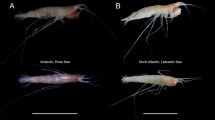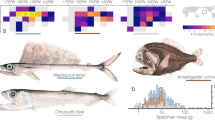Abstract
A baited trap set on the bottom (4855 m) in the eastern North Atlantic Ocean caught over 600 specimens belonging to 7 species of lysianassid amphipods. Photographic evidence showed a slow build up of numbers and demonstrated fluctuations apparently related to current and pressure changes and to the presence of fish. Length-frequency distributions for the more abundant species reveal size classes related to growth stages. Paralicella caperesca produces a single brood of about 90 eggs. Maturity in this species may be attained in 7 to 11 moults, the precise number possibly being determined by food availability. Orchomene gerulicorbis requires about 11 moults to reach maturity, and females are double-brooded. Mortality within the trap is discussed. A comparison of species of Paralicella and Orchomene based on morphological, developmental, reproductive and ecological characters indicates that the former genus are specialized necrophages whereas the latter are opportunist generalists. The abundance and mobility of necrophagous amphipods indicate that they play a very significant role in the trophic web.
Similar content being viewed by others
Literature Cited
Aldred, R.G., M.H. Thurston, A.L. Rice and D.R. Morley: An acoustically monitored opening and closing epibenthic sledge. Deep-Sea Res. 23, 167–174 (1976)
Baker, A. de C., M.R. Clarke and M.J. Harris: The N.I.O. combination net (RMT 1+8) and further developments of rectangular midwater trawls. J. mar. biol. Ass. U.K. 53, 167–184 (1973)
Barnard, J.L.: Gammaridean Amphipoda from depths of 400 to 6000 meters. Galathea Rep. 5, 23–128 (1961)
—: South Atlantic abyssal amphipods collected by R. V. Vema. In: Abyssal Crustacea, pp 1–78. New York: Columbia University Press 1962
—: The families and genera of marine gammaridean Amphipoda. Bull. U.S. natn. Mus. 271, 1–535 (1969)
— and E. Shulenberger: Clarification of the abyssal amphipod, Paralicella tenuipes Chevreux. Crustaceana 31, 267–274 (1976)
Bellan-Santini, D.: Intertébrés marins des XIIeme et XVeme expeditions antarctiques françaises en Terre Adélie 10. — Amphipodes gammariens. Téthys Suppl. 4, 157–228 (1972)
Bregazzi, P.K.: Life cycles and seasonal movements of Cheirimedon femoratus (Pfeffer) and Tryphosella kergueleni (Miers) (Crustacea: Amphipoda). Br. Antarct. Surv. Bull. 30, 1–34 (1972)
Bruun, A.F.: Deep sea and abyssal depths. In: Treatise on marine ecology and paleoecology. Vol. 1. Ecology, pp 641–672. Ed. by J.W. Hedgpeth. New York: Geological Society of America 1957. (Mem. geol. Soc. Am. No. 67)
Cassie, R.M.: Some uses of probability paper in the analysis of size frequency distributions. Aust. J. mar. Freshwat. Res. 5, 513–522 (1954)
Charniaux-Cotton, H.: Sex determination. In: The physiology of Crustacea. Vol. 1. Metabolism and growth, pp 411–447. Ed. by T.H. Waterman. New York: Academic Press 1960
Chevreux, E.: Diagnoses d'amphipodes nouveaux provenant des Campagnes de la Princesse-Alice dans l'Atlantique nord. Bull. Inst. océanogr., Monaco 117, 1–13 (1908)
—: Amphipodes provenant des Campagnes scientifiques du Prince Albert Ier de Monaco. Résult. Camp. scient. Prince Albert I 90, 1–214 (1935)
George, R.Y. and R.J. Menzies: Indication of cyclic reproductive activity in abyssal organisms. Nature, Lond. 215, p. 878 (1967)
——: Further evidence for seasonal breeding cycles in the deep sea. Nature, Lond. 220, 80–81 (1968)
Haedrich, R.L. and N.R. Henderson: Pelagic food of Coryphaenoides armatus a deep benthic rattail. Deep-Sea Res. 21, 739–744 (1974)
Harding, J.P.: The use of probability paper for the graphical analysis of polymodal frequency distributions. J. mar. biol. Ass. U.K. 28, 141–153 (1949)
Hessler, R.R., C.L. Ingram, A.A. Yayanos and B. R. Burnett: Scavenging amphipods from the floor of the Philippine Trench. Deep-Sea Res. (In press)
—, J.D. Isaacs and E.L. Mills: Giant amphipod from the abyssal Pacific Ocean. Science, N.Y. 175, 636–637 (1972)
— and H.L. Sanders: Faunal diversity in the deep-sea. Deep-Sea Res. 14, 65–78 (1967)
Isaacs, J.D.: The nature of oceanic life. Scient. Am. 221 (3), 146–162 (1969)
— and R.A. Schwartzlose: Active animals of the deep-sea floor. Scient. Am. 233 (4), 84–91 (1975a)
——: Biological applications of underwater photography. Oceanus 18, 24–30 (1975b)
Jannasch, H.W.: Experiments in deep-sea microbiology. Oceanus 21 (1), 50–57 (1978)
— and C.O. Wirsen: Deep-sea microorganisms: in situ response to nutrient enrichment. Science, N.Y. 180, 641–643 (1973)
Macdonald, A.G.: The role of high hydrostatic pressure in the physiology of marine animals. Symp. Soc. exp. Biol. 26, 209–231 (1972)
Menzies, R.J.: Conditions for the existence of life on the abyssal sea floor. In: Oceanography and marine biology, Vol. 3. pp 195–210. Ed. by H. Barnes. London: Allen & Unwin 1965
Orton, J.H.: Sea-temperature, breeding and distribution in marine animals. J. mar. biol. Ass. U.K. 12, 339–366 (1920)
Paul, A.Z.: Trapping and recovery of living deep-sea amphipods from the Arctic Ocean floor. Deep-Sea Res. 20, 289–290 (1973)
Pearcy, W.G. and J.W. Ambler: Food habits of deep-sea macrourid fishes off the Oregon coast. Deep-Sea Res. 21, 745–759 (1974)
Przibram, H.: Quanta in biology. Proc. R. Soc. Edinb. 49, 224–231 (1929)
Rice, A.L., R.G. Aldred, D.S.M. Billett and M.H. Thurston: The combined use of an epibenthic sledge and a deep-sea camera to give quantitative relevance to macro-benthic samples. Ambio (In press)
Rokop, F.J.: Reproductive patterns in the deep-sea benthos. Science, N.Y. 186, 743–745 (1974)
—: Patterns of reproduction in the deep-sea benthic crustaceans: a re-evaluation. Deep-Sea Res. 24, 683–691 (1977)
Sanders, H.L.: Marine benthic diversity: a comparative study. Am. Nat. 102, 243–282 (1968)
— and R.R. Hessler: Ecology of the deep-sea benthos. Science, N.Y. 163, 1419–1424 (1969)
Sars, G.O.: An account of the Crustacea of Norway with short descriptions and figures of all the species, 711 pp. Christiania: Cammermeyers 1890–1895
Schellenberg, A.: Die Gammariden der Deutschen Südpolar-Expedition 1901–1903. Dt. Südpol. —Exped. (Zool.) 18 (10), 233–414 (1926)
Schoener, A.: Evidence for reproductive periodicity in the deep sea. Ecology 49, 81–87 (1968)
Sexton, E.W.: The moulting and growth stages of Gammarus, with descriptions of the normals and intersexes of G. chevreuxi. J. mar. biol. Ass. U.K. 13, 340–401 (1924)
Shih, C.-T.: The systematics and biology of the Family Phronimidae (Crustacea: Amphipoda). Dana Rep. 74, 1–100 (1969)
Shulenberger, E. and J.L. Barnard: Amphipods from an abyssal trap set in the north Pacific gyre. Crustaceana 31, 241–258 (1976)
— and R.R. Hessler: Scavenging abyssal benthic amphipods traped under oligotrophic central North Pacific Gyre waters. Mar. Biol. 28, 185–187 (1974)
Steele, D.H. and V.J. Steele: The biology of Gammarus (Crustacea, Amphipoda) in the north-western Atlantic. XI. Comparison and discussion. Can. J. Zool. 53, 1116–1126 (1975)
Sulak, K.K.: The systematics and biology of Bathypterois (Pisces, Chlorophthalmidae) with a revised classification of benthic myctophiform fishes. Galathea Rep. 14, 49–108 (1977)
Thurston, M.H.: The vertical distribution and diurnal migration of the Crustacea Amphipoda collected during the SOND Cruise, 1965. I. The Gammaridea. J. mar. biol. Ass. U.K. 56, 359–382 (1976)
Vader, W.: Notes on Norwegian marine Amphipoda. 5. New records of Leptamphopus sarsi (Calliopiidae). Sarsia 50, 25–28 (1972)
Walker, A.O.: Crustacea. III. — Amphipoda. Natn. Antarct. Exped. 1901–1904 (Nat. Hist., 3, Zool. Bot. 3) 1–39 (1907)
Wolff, T.: Archimède Dive 7 to 4160 metres at madeira: observations and collecting results. Vidensk. Meddr dansk naturh. Foren. 134, 127–147 (1971)
Author information
Authors and Affiliations
Additional information
Communicated by J. Mauchline, Oban
Rights and permissions
About this article
Cite this article
Thurston, M.H. Scavenging abyssal amphipods from the North-East Atlantic ocean. Marine Biology 51, 55–68 (1979). https://doi.org/10.1007/BF00389031
Accepted:
Published:
Issue Date:
DOI: https://doi.org/10.1007/BF00389031




